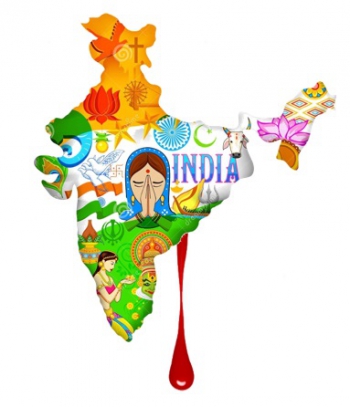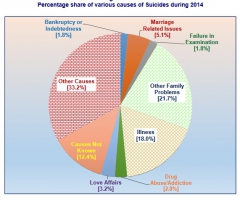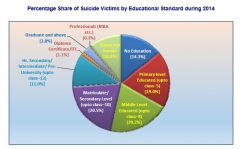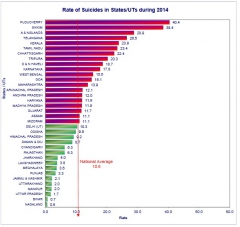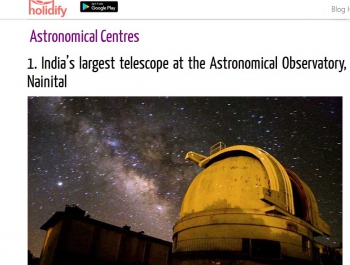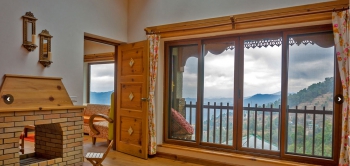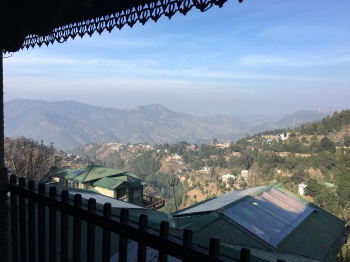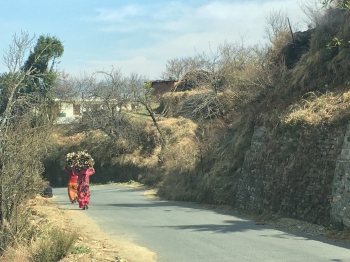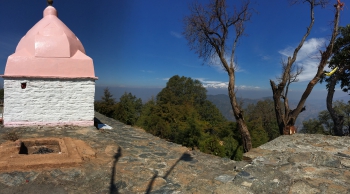05/08/2017
About depression, suicide and other niceties
The Indian Prime Minister spoke recently about a problem (apparently independent of the lack of toilets and corruption) completely taboo and not really funny: depression.
Apparently the WHO published a report on depression in Southeast Asia in 2015 (source), then India (the National Institute of Mental Health and Neuro Science) conducted a study published in 2016 (source).
If there was in the world in 2015 more than 300 million people suffering from depression (4.6% of the population*), 56 million lived in India (4.5% of the Indian population, right in the overall average!). To that we need to add all the other mental illnesses, which brings to 15 the percentage of adults who actually need help.
But the thing is that in India, mental conditions are hyper stigmatized**. You don't go to a shrink (that's for crazy people (maybe that’s why there are only 2 psychiatrists per million inhabitants which means there are less than 3 000 in total!)) (source)), you hide it, you ignore it. It doesn’t really help to get better.
In the same vein, there are a lot of suicides in India. On average 134 419 a year between 2010 and 2014, or 10.6 per 100,000 people (source). I won’t give a ranking of countries, it varies too much from one source of information to another, but this rate is also aligned with the global statistics of 10.7 per 100,000 people in 2015 (source). “Each year, almost 800,000 people die by committing suicide. Suicide is the second leading cause of mortality in the 15-29 age group.” (source)
After talking a lot about the suicides of farmers, there is now a rising consciousness about the youth (with a suicide rate among the highest in the world according to the Lancet 2012), with nearly 9,000 students who killed themselves in 2015. The reasons stated are the pressure for academic and professional success, fear of failing and to be not good enough, as well as the difficulties to communicate with parents (source). In a society that is changing so fast, parents who sweat blood to work themselves out of poverty and expect the same of their children, joint families where communication on sensitive issues can be often silenced, a generational gap becoming abysmal between parents and children, and the social stigma, it's not easy for a lot of young people out here!
* In France, 2 to 3 million people suffer from depression, i.e. 5 to 8% (source), which puts us in the global standard with 4.5% of the population.
** “From a cultural perspective, mental disorders are associated with a considerable amount of stigma in Indian society, leading to neglect and marginalisation.Such individuals and their families face numerous challenges in daily life, both for managing the condition as well as for making them productive due to prevailing attitudes, media portrayals, societal discrimination and deprived opportunities.” (source)
08:00 Posted in Incredible India! | Permalink | Comments (0) | Tags: india, suicide, depression, mental diseases, mental illnesses | ![]() Facebook | |
Facebook | |
04/17/2017
Head in the stars (or not)
To make my favorite Indian dream a bit, I decided to surprise him and celebrate his birthday under a starry sky – it has kind of become his thing, stars, since we watched Cosmos on Netflix!
To begin with the beginning, I googled “best places to watch stars in India” and fell upon this:
Super excited (especially since this place was somehow accessible), I searched how to visit this thing at night. But they don’t do night visits anymore, only in daytime. It did seem kind of weird to watch stars in broad day light but in India everything was possible (and why else would they have daytime visit?), so my brain didn’t dwell too long on this issue. All the more because my colleague confirmed it was a great place and you could see the stars there!
I had to fill a form online, and be aware, you must do so at least 30 days in advance. Exactly one month before the D day, between two market visits, I managed to do it and good for me because the website stopped operating for the next two weeks! (I visited it regularly to see if my request had been accepted.)
The next step was to book a room not too far from Nainital. Especially not in Nainital, a small crowded bustling town that is not really charming for my taste. Fortunately there are a lot of ‘boutique hotels’ in the area. Soulitude knew how to seduce me, by its name, by its website mentioning ‘star gazing’ as an activity and by its room which had glass ceilings to see the stars. And there was only one room left when I booked three weeks in advance, I saw this as a sign!
Finally the day came to go on our trip. We managed pretty nicely the 9-hour drive separating the mountains of Uttarakhand from Gurgaon. A smooth trip, with baby Samurai quite quiet. Immediately upon arrival we went for a walk; and I was a little worried because the sky was quite cloudy. Okay Indians can do impossible stuff but even if they manage to see the stars with the Sun, I was pretty sure that clouds would be an obstacle!
The next day, the sky is a bit clear and we drive two hours to go to the Observatory. At the time of the appointment, not one living soul in sight. Ah wait, I see a guard. Who, even if he doesn’t seem to understand what we are doing here, tells us that the team is having lunch and that it might take a while because they have no car and that the dining hall is pretty far. So we offer to do the taxi.
The Chief Scientist assigned to us isn't here. Instead we have an assistant computer engineer. Showing us a little video on the history of the Observatory. Then he takes us to the beast. And... voilà! In fact of stars we got to watch a telescope. No comment.
The hotel had no human scale telescope; as activity, they had just a guest coming regularly with his own material to take pictures. But the sky was beautiful, more than in Gurgaon. Even if the end of the winter (mid-February) is not the best season to go, as clouds form with the warming of earth.
And also Soulitude is mostly just a name: it is built between two other houses, and work is ongoing. Nevertheless the hotel is very nice (especially our room a bit away from the main building), the staff helpful and the food very good.
We both love the mountains of this corner of the India, so no regrets, it was a great weekend, one of those who comes with a price (namely a 2 day drive on Indian roads)!
PS: Come to think if it, I must have mistaken between an Observatory and planetarium?
Kumaon Hills
08:01 Posted in Incredible India!, My stories in India, Travelling (in India!) | Permalink | Comments (0) | Tags: india, uttarakhand, nainital, stars, observatory, soulitude | ![]() Facebook | |
Facebook | |
04/03/2017
25 million warrior moms give birth every year in India
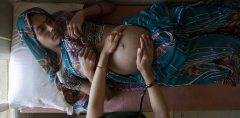 In 2000, the Indian Government ratified the objectives of the Millennium for the Development of the United Nations thus committing to reduce child mortality and improve maternal health by 2015.
In 2000, the Indian Government ratified the objectives of the Millennium for the Development of the United Nations thus committing to reduce child mortality and improve maternal health by 2015.
The proposed solution for the India by Indians was: to make sure all women give birth in a hospital.
The proposed method: free care at the public hospital and reimbursement of the transportation costs. And as a side effect, discrediting the dais (traditional Indian midwives with oral and practical knowledge but no diploma) as well as midwives in the Western sense whose profession has been removed of the map – in the 1960s, the India ‘created’ the profession of ‘Auxiliary Nurse Midwives’ to be later replaced by ‘General Nurse Midwives’ (source). All that to encourage women to move away from the traditional system of giving birth at home and rather to go and see the ‘professionals’ at the hospital where treatment could be provided. In itself the idea makes sense I reckon. Yes except that (it’s upsetting, for every measure that the Indian authorities take there is a ‘but’)...
The goal was not achieved despite a huge drop in infant mortality (from 374 per 100,000 births in 2000, it decreased to 174 in 2015 compared to a target of 139). At the same time the number of deliveries at the hospital are believed to have gone up from 25 to 79% according to Unicef (source). Except that it seems that these two trends are in fact not related! But obviously the Government was tempted by the shortcut – who wouldn’t be? But no. According to Jishnu Das, an economist at the World Bank, infant and maternal mortality has fallen ‘simply’ because women are fewer children: 3.3 children per woman in 2000 (5.9 in 1960!) to 2.1 in 2015. I dont completely see the link, but he looked quite sure of himself.
On the other hand it became crazy in the hospitals. And I can testify, since I visit hospitals (public and private) for work.
In the (overcrowded) cities, public hospitals (which do not have the right to refuse patients) are overloaded, with three women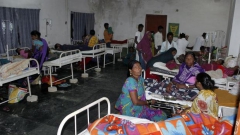 sharing a bed when they are lucky enough to find one. With women often treated like shit (because they are poor and illiterate and a doctor is a bit of a God since he saves lives). Or who are slapped by the medical profession when they scream too loudly because of the pain (source). And with women who must give birth alone, because the relatives (even the mother or husband) are not allowed in the labour room.
sharing a bed when they are lucky enough to find one. With women often treated like shit (because they are poor and illiterate and a doctor is a bit of a God since he saves lives). Or who are slapped by the medical profession when they scream too loudly because of the pain (source). And with women who must give birth alone, because the relatives (even the mother or husband) are not allowed in the labour room.
And on the other hand you have understaffed doctors and nurses who have to give birth to dozens of babies at the same time (it is hard to keep your humanity and empathy when you do chain work I guess – in any case that's what thinks the President of the Association of Indian Gynaecologists: “We will first ensure care for all before talking about respect”). And sometimes these professionals get lynched by villagers if everything doesn’t go as well as planned. Literally. Like, they get stoned.
In cities and private hospitals for the richest, abuses are of a different kind, because it’s hard to insult those who sign a (big) check. Here again I can testify with my own delivery and of most of those around me. Abuse or violence takes the shape of ‘forced’ caesarean sections, unnecessary inducements, opening of the cervix by hand. Which sadly doesn’t happen only in India it seems. And then as soon as babies are born they are stuffed with formula (I mean it, they are more often than not given a dose which is three times the size of their stomach so that they sleep and let their mother rest). However preventing newborns to nurse within the first hour can have lasting and damaging consequences for breastfeeding later on.
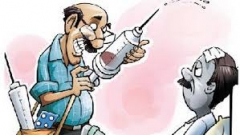 Of course there are also ‘good’ doctors. But apart from the fact that they are not easy to find, they are also under pressure from the hospitals which considers the patient rotation as a Key Indicator of Performance. There are also a few birth houses in the country (one in Hyderabad and one in Cochin).
Of course there are also ‘good’ doctors. But apart from the fact that they are not easy to find, they are also under pressure from the hospitals which considers the patient rotation as a Key Indicator of Performance. There are also a few birth houses in the country (one in Hyderabad and one in Cochin).
That’s why we can observe a micro-movement of affluent women who decide to give birth at home accompanied by a trained midwife (i.e. able to recognize when there is an emergency that requires a gynaecologist intervention and a hospital set-up) (source)).
Finally, in the (not overcrowded) countryside, they miss material, blood, qualified doctors, and caesareans required to save lives can not be carried out.
In short the situation is not very simple isn’t it? Not simple, and not glorious.
For the situation to improve we must tell women (all women really because even the educated and privileged ones like me are not aware) that birthing takes time and that it’s okay to not rush things. That birthing bloody hurts but it’s not what matters in the end, because it’s so much more than the pain (without being puppy sentimental), after all “we’re here to suffer” says my father as soon as we start hiking. That birthing is a natural process and that unless there are complications the mother can do everything alone; she’s stronger that she believes and she must trust her body. That episiotomy doesn't need to be systematic. And that regardless of the type of delivery, the baby should be placed on the mother's chest immediately after birth.
People must also make an effort to choose their doctor. The ‘scoring’ system certainly helps: there are websites/apps where patients note doctors and comment on the quality of care they received. This helps to make a more informed choice even though in general there are too many different comments. And when you think that almost 60% of the allopathic doctors in India would actually not have diploma (or even generally not have studied medicine at all), you freak out.
Doctors should agree to come down from their pedestals (at least most of them). Hospitals should get more of them and nurses and the medical cursus needs to be improved (a little bit of patient psychology wouldn’t hurt, but it is my personal opinion).
The idea of trained midwives with a formal curriculum and real responsibilities for non-complicated, non-risky deliveries (a bagatelle in 80% of cases) thus relieving gynaecologists and allow them to focus on problematic births should be seriously considered. That’s apparently what did Sri Lanka successfully, even spending less money than Indian in reducing mortality at birth! (source) And if "Sri Lanka can do it, so can we (India)!" Provided people acknowledge that things are not so pretty here...
08:00 Posted in Incredible India!, My stories in India | Permalink | Comments (0) | Tags: india, childbirth, birth, birthing, labour, maternal mortality, infant mortality, death, infants, c-section, ceasarians, gynec, doctors, nurses, midwives | ![]() Facebook | |
Facebook | |















